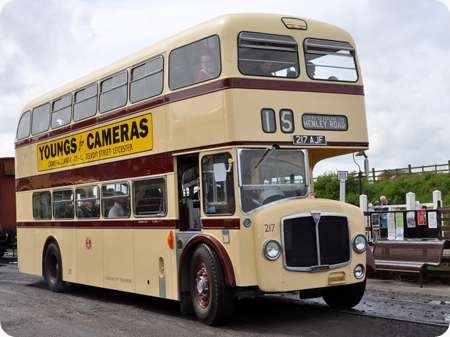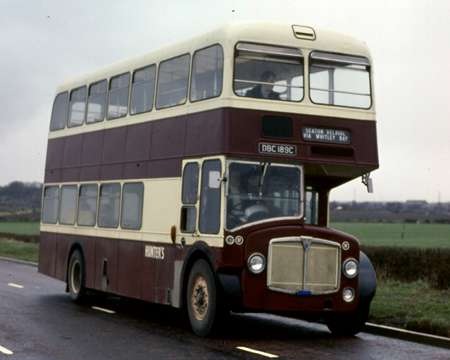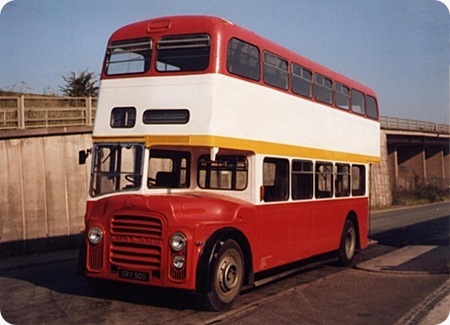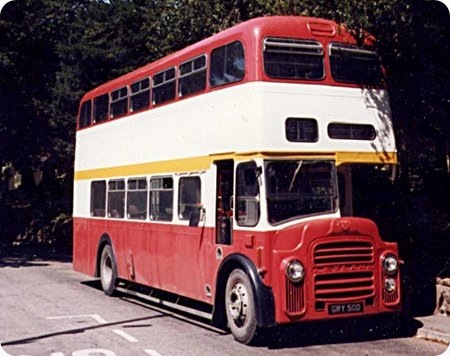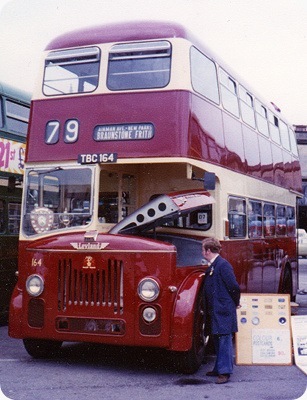Leicester City Transport – AEC Bridgemaster – 217 AJF – 217
Leicester City Transport
1961
AEC Bridgemaster B3RA
Park Royal H45/31R
217 AJF Leicester City 217 was one of the first vehicles to be delivered in the new cream livery with three maroon bands. It was withdrawn from service in 1971, worked for other companies until 1998 when it was bought for preservation and is now owned by individual members of the Leicester Transport Heritage Trust. It originally had only 72 seats but an additional row was inserted in the upper deck in 1963. It has been fully operational since 2011. More information can be found at this link.
Photograph and Copy contributed by Ken Jones
08/05/14 – 07:53
It just shows how even an ugly duckling like the Bridgemaster can be enhanced by a quality livery. Good to see it preserved and in running order.
Ian Wild
08/05/14 – 07:54
Isn’t this livery just much more dignified than the red/grey/white Leicester City Council corporate livery that came after? – we’ll paint our buses the same colour as our "bin waggons" because, presumably, we think our passengers are rubbish. When I first visited Leicester in 1984 the LCT operation had echoes of various conflicting past ages: Ultimate and Solomatic ticket machines; and, yes, conductor operation; but two-door buses abounded; and on some one man buses change was delivered down a chute from a change-giver situated by the driver’s left shoulder (Roger Cox – or indeed anybody living in Halifax late 60’s/early 70’s . . . or in fact in Leicester late 70’s-late 80’s! – will get the picture). LCT was the first time I saw drivers/conductors wearing flat-caps as a matter of course – now, around in First Leeds country, if I ever spot a driver wearing a cap, then the odds are in favour it being a non-uniform baseball cap.
In how many respects was the Bridgemaster a low-height-cut-price-Routemaster-for-the-provinces?
And what a bloody indulgence of LCT to buy a small number of buses they subsequently decided were non-standard (didn’t see that coming then!) and so dispose of prematurely . . . all on the backs of their rate-payers presumably.
Philip Rushworth
08/05/14 – 10:58
The Bridgemaster was an AEC/Park Royal integral model, but there the resemblance to the Routemaster stopped. Among the most obvious differences the Bridgemaster was only available with a manual gearbox, it did not have power steering, was a lowheight design and completely different in appearance!
Don McKeown
08/05/14 – 10:59
Phil They also bought AEC Renowns which also left early along with the non standard Daimler CSG6/30s bought in the early sixties.
Many years ago Leeds bin wagons were a very similar shade to the buses while the lighting dept used blueand the direct works dept used grey The in the late sixties early seventies everything apart from the buses went bright red In Lancaster the bus shelters and the dust carts are still using Trafalgar blue the colour used fro the buses from 1974 to their demise Perhaps they overstocked!
Chris Hough
08/05/14 – 10:59
It is said that following the loan of a Sheffield Transport bus, the general manager of Leicester was so impressed with the blue and cream livery that he decided to adorn his buses with a virtually identical scheme in maroon and cream. Details of the Sheffield bus escape me at present, but what excellent taste that man had!
John Darwent
08/05/14 – 11:45
Variations on a theme. DBC 189C was a H44/31F East Lancs bodied AEC Renown, new to Leicester City Transport in 1965. Around the mid to late 70’s. it was sold to Hunter of Seaton Delaval, and is pictured in service with them on the road between Earsdon and Seaton Delaval. Did it too start life in the rather smart version of the Leicester livery?
Ronnie Hoye
09/05/14 – 08:56
Ronnie. Yes. John. Could it have been one of Sheffield’s 519-524 batch of similar Bridgemasters? Sheffield never had any particular problems with either Regent Vs or Bridgemasters in their mountainous operating area – and all achieved a full working life (12/13 for Bridgemaster and 13-17 for Regent V).
David Oldfield
09/05/14 – 08:56
The previous Leicester livery was not unlike the Hunters livery with the window surrounds in cream and the rest in maroon.
Chris Hough
09/05/14 – 09:58
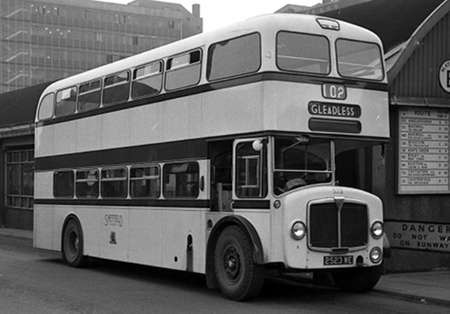
Photograph by ‘unknown’ if you took this photo please go to the copyright page.
David – May well have been a Sheffield Bridgemaster on loan. Pretty similar apart from opening top deck front windows. Go compare.
John Darwent
09/05/14 – 12:46
…..and as Ian said, at the top, what a difference a livery can make – just like on the Orion. Even 525, of the ugliest of PRV designs, looks good in STD livery – as it still does in preservation.
Question for all our experts out there. Recent reading has brought up an number of "forgotten" facts. One is the legislation requiring a downstairs emergency exit on 30′ long deckers. The Leicester Bridgemaster has one behind the driver’s cab, the "normal" position. Apart from those with platform doors – where the emergency exit was a door at the rear of the platform – only the Alexander Regent Vs of Sheffield had the additional emergency exit behind the driver. Why? Did the legislation come in during the course of 1960? STD’s Roe and Weymann Regent Vs arrived between January and April 1960. The Alexanders were the last to arrive, again in April.
David Oldfield
10/05/14 – 08:59
Leeds later 30 foot vehicles had an emergency window in the first bay on the offside rather like an upper deck emergency window
Chris Hough
10/05/14 – 08:59
Dont know for certain, David. By 1960 the NGT Group had entered the world of the Atlantean. The lower deck emergency exit was on the O/S between the rear axle and the engine. The only half cabs required to have an emergency exit on the lower deck were the SDO R/D Burlingham bodied PD3’s. They had a door on the back at the foot of the stairs, the Routemasters (O/S rear behind the axle, and the Ex East Yorkshire Renowns (centre rear). The Orion bodied PD3’s had the standard cut away section of the open platform which extended round the back, and allowed an escape route should the vehicle end up on its side.
Ronnie Hoye
10/05/14 – 08:59
The requirement for an additional emergency exit must have come in around 1959. The Leeds PD3s with Roe bodies didn’t have it but the tram replacement Daimlers in the reversed UA series did.
David Beilby
10/05/14 – 12:36
Thanks chaps. I was aware of the Leeds vehicles, Chris and David. Still anecdotal though. We’ve not pinned down a date, just more or less confirmed it by detection.
David Oldfield
11/05/14 – 08:21
There’s a small booklet that was produced by the Leicester Transport Heritage Trust in 2011 called "Maroon to Cream", The Story of Leicester City Transport’s Livery Change, by Mike Greenwood, which details the revision to the Leicester livery and highlights the Sheffield connection; it’s a fascinating little booklet that is well worth a read.
Dave Careless
11/05/14 – 08:22
Off-subject though this may be, I query the random positioning of front number plates on buses, and whether they were perhaps not subject to he Construction and use Regulations by which cars and motorcycles were bound.
Above we see Leicester Corp. Bridgemasters cast their plate high above the cab, under the destination indicator, BTC oft used a square plate slung the left under the cab, where the standard spot was at the base of the radiator – sometimes actually attached to the grille.
The only two ‘lets’ which I know to have been permitted in commercials, have been the rear plate of pantechnicons mounted atop the roof at right, and London Transport bypassing the white and yellow plates prescribed for all other vehicles in GB, by continuing with white on black. These allowances must have been arranged by the most complex legal wrangling and alteration of otherwise immutable law.
Thanks to all correspondents.who make this such a lively forum, with remarkable knowledge of the minutiae of omnibology and simply wonderful archive photographs, now saved for posterity by their exposure in OBP.
Victor Brumby
11/05/14 – 17:38
Leeds buses had a square registration plate affixed under the cab windscreen. However All the exposed radiator MCW Orion stock had a straight plate under the windscreen. The 60 all Leyland Titans had a transfer straight number plate under the cab window. The concealed radiator Daimler had a plate at the bottom of the tin front later Daimlers with Manchester style cowls reverted to the square cast plate. Later concealed Titans and Regents had their plates at the bottom of their tin fronts. All rear entrance buses had a square plate in the offside rear corner. These were usually painted. The last rear entrance Leeds buses 1966 AEC Regent had an illuminated plate over the rear platform window. All rear engined types had a plate at the bottom of the front dash positioned between the tow points. All rear engined deckers had a rear plate over the back window.
Chris Hough
12/05/14 – 08:34
Lincoln Corporation`s four Bridgemasters followed on from Leicester`s final batch by chassis nos. Does anyone know if they were cancelled by Leicester?
Lincoln were wedded to Leyland/Roe products and went back to them for several years. I have always wondered if they bought them at a bargain price, particularly as they were in the same traffic area and maybe the general managers were good pals?
Steve Milner
12/05/14 – 08:40
Manchester had square plates under the cab window as radiators were exchanged from time to time. There is a photo in The Manchester Bus of a vehicle carrying two different registrations after Burlingham delivered the first batch of the 1958 PD2s with plates on the bottom of the radiator and a swap was done later with a radiator for a 1959 Orion bodied PD2 and the mechanic failed to remove the plate from the original vehicle which would , along with its new radiator, have received the standard square plate. This left the newer vehicle with a correct UNB registration and an incorrect TNA one. The second batch of 1958 PD2s received square plates prior to delivery after Burlingham were reminded of Manchester’s requirements.
I don’t know of any hard and fast rules prior to the introduction of reflective plates, by which time, of course, front engined buses were being phased out by the manufacturers.
Phil Blinkhorn
Quick links to the - Comments Page - Contact Page - Home Page
